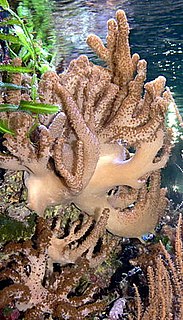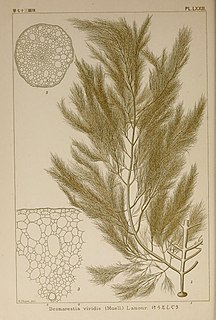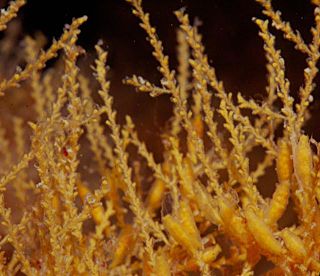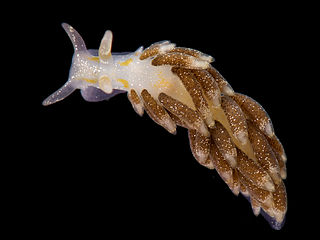
The Portuguese man o' war, also known as the man-of-war, bluebottle, or blue bottle jellyfish, is a marine hydrozoan found in the Atlantic Ocean and the Indian Ocean. It is considered to be the same species as the Pacific man o' war, which is found mainly in the Pacific Ocean.

Alcyonacea, or soft corals, are an order of corals. In addition to the fleshy soft corals, the order Alcyonacea now contains all species previously known as "gorgonian corals", that produce a more or less hard skeleton, though quite different from "true" corals (Scleractinia). These can be found in suborders Holaxonia, Scleraxonia, and Stolonifera. They are sessile colonial cnidarians that are found throughout the oceans of the world, especially in the deep sea, polar waters, tropics and subtropics. Common names for subsets of this order are sea fans and sea whips; others are similar to the sea pens of related order Pennatulacea. Individual tiny polyps form colonies that are normally erect, flattened, branching, and reminiscent of a fan. Others may be whiplike, bushy, or even encrusting. A colony can be several feet high and across, but only a few inches thick. They may be brightly coloured, often purple, red, or yellow. Photosynthetic gorgonians can be successfully kept in captive aquaria.

Bryopsis is a genus of marine green algae in the family Bryopsidaceae. It is frequently a pest in aquariums, where it is commonly referred to as hair algae.

The Bissekty Formation is a geologic formation and Lagerstätte which crops out in the Kyzyl Kum desert of Uzbekistan, and dates to the Late Cretaceous Period. Laid down in the mid to late Turonian, it is dated to about 92 to 90 Ma.

Thelidomus is a genus of air-breathing land snails, terrestrial pulmonate gastropod mollusks in the family Pleurodontidae.

Jean Vincent Félix Lamouroux was a French biologist and naturalist, noted for his seminal work with algae.

Desmarestia viridis is a species of brown algae found worldwide. Its common names include stringy acid kelp, green acid kelp, Desmarest's green weed, and sea sorrel, though the last name can refer to other species of Desmarestia. The light brown thallus is delicate with a disc-shaped holdfast. It releases sulfuric acid when damaged, destroying itself and nearby seaweeds in the process. They are found in shallow intertidal areas.

Laurencia is a genus of red algae that grow in temperate and tropical shore areas, in littoral to sublittoral habitats, at depths up to 65 m (213 ft).

Plexauridae is a family of marine colonial octocorals in the phylum Cnidaria. Members of this family are found in shallow tropical and subtropical seas. Many species contain symbiotic photosynthetic protists called zooxanthellae.

Sertularella is a genus of hydroids in the family Sertulariidae.

Trinchesia foliata is a species of sea slug, an aeolid nudibranch, a marine gastropod mollusk in the family Trinchesiidae.

Sertularella polyzonias is a branching colonial hydroid in the family Sertulariidae.

Dictyota is a genus of seaweed in the family Dictyotaceae. Species are predominantly found in tropical and subtropical seas, and are known to contain numerous chemicals (diterpenes) which have potential medicinal value. As at the end of 2017, some 237 different diterpenes had been identified from across the genus.
Sertularella acutidentata is a branching colonial hydroid in the family Sertulariidae.
Sertularella crassa is a branching colonial hydroid in the family Sertulariidae.
Sertularella decipiens is a branching colonial hydroid in the family Sertulariidae.
Sertularella inconstans is a branching colonial hydroid in the family Sertulariidae.
Sertularella ellisii is a branching colonial hydroid in the family Sertulariidae.

Hispaniolana is a genus of air-breathing land snails, terrestrial pulmonate gastropod mollusks in the subfamily Polydontinae of the family Sagdidae.













